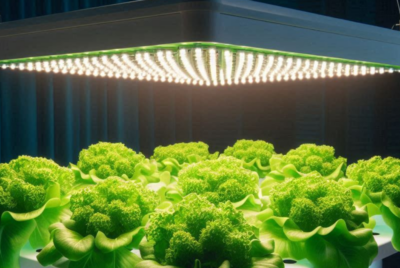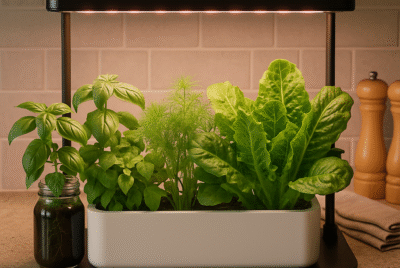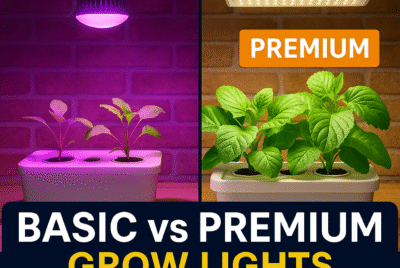How to Grow Hydroponic Tomatoes: Unlock Juicy Delights
Hydroponic gardening is becoming increasingly popular among gardening enthusiasts and for good reason. It’s a convenient way to grow plants without soil, and it allows you to grow a variety of plants, including tomatoes. In this article, I will share my knowledge and experience on how to grow hydroponic tomatoes successfully.
Before we dive into the specifics of growing hydroponic tomatoes, let’s first understand what hydroponics is. Hydroponics is a method of growing plants without soil, where plants receive nutrients directly from water. Hydroponic tomatoes are grown in a controlled environment, usually in a hydroponics kit, and the nutrient solution is carefully monitored and adjusted to meet the plant’s needs.
Benefits of Growing Hydroponic Tomatoes
There are several benefits to growing hydroponic tomatoes.
Here are some of the advantages:
- Faster growth rate: Hydroponic tomatoes grow faster than those grown in soil due to the direct delivery of nutrients to the roots.
- Higher yield: Hydroponic tomatoes produce a higher yield compared to traditional soil-grown tomatoes.
- Better quality: Hydroponic tomatoes tend to be larger, juicier, and have a more intense flavor than soil-grown tomatoes.
- Controlled environment: Growing hydroponic tomatoes allows you to have better control over the growing conditions, such as temperature, light, and humidity.
Setting Up Your Hydroponic Tomato System

Now that you know the benefits of growing hydroponic tomatoes let’s get started on how to set up your hydroponic tomato system. Here are the steps:
Step 1: Choose the Right Hydroponic System:
There are several types of hydroponic systems available in the market, including deep water culture, nutrient film technique, and aeroponics. Each system has its pros and cons, so choose the one that best suits your needs and budget.
Step 2: Select the Right Tomato Variety:
Not all tomato varieties are suitable for hydroponic gardening. Choose a tomato variety that is known to thrive in hydroponic systems, such as Beefsteak, Roma, or Cherry tomatoes.
Step 3: Prepare the Growing Medium:
Hydroponic tomatoes require a growing medium to support the plants and provide stability to the roots. Some popular growing mediums for hydroponic tomatoes include perlite, vermiculite, and coconut coir.
Step 4: Mix the Nutrient Solution:
The nutrient solution is a crucial component of hydroponic gardening. You can buy pre-made nutrient solutions from your local gardening store or make your own. The nutrient solution should contain a balanced mix of nitrogen, phosphorus, and potassium, as well as other essential micronutrients.
Step 5: Install the System:
Once you have all the components ready, it’s time to install the hydroponic system. Follow the manufacturer’s instructions carefully, and make sure all the components are securely in place.
Select the right tomato variety

Not all tomato varieties are suitable for hydroponic growing, so it’s important to select the right one. Some of the best tomato varieties for hydroponics include cherry tomatoes, beefsteak tomatoes, and heirloom tomatoes. These varieties have been proven to perform well in hydroponic systems.
Prepare the nutrient solution
The nutrient solution is the key to hydroponic growing, as it provides the plants with all the necessary nutrients. You can either purchase it pre-made nutrient solutions or make your own using fertilizers and supplements. It’s important to follow the instructions carefully and monitor the pH levels regularly to ensure the plants are getting the right nutrients.
Start the seeds
Starting tomato seeds for hydroponic growing is similar to starting them for traditional soil-based gardening. You can either start the seeds indoors or purchase seedlings from a nursery. It’s important to keep the seeds warm and moist until they germinate, and to provide them with plenty of light once they sprout.
Transplant the seedlings
Once the seedlings have grown to a suitable size, it’s time to transplant them into the hydroponic system. Carefully remove the seedlings from their containers and place them into the growing medium, being careful not to damage the roots. Make sure the plants are properly supported and adjust the nutrient solution as needed.
Monitor and maintain the plants
Hydroponic tomatoes require regular monitoring and maintenance to ensure they grow properly. This includes monitoring the pH levels, nutrient levels, and water levels, as well as pruning the plants and removing any dead or diseased foliage. It’s also important to keep the growing area clean and free of pests and diseases.
Maintaining Your Hydroponic Tomato System

Congratulations! You have set up your hydroponic tomato system. Now, the next step is to maintain it properly.
Here are some tips to help you:
Tip 1: Monitor the pH Levels
The pH level of the nutrient solution is crucial for the plants’ growth and health. The ideal pH level for hydroponic tomatoes is between 5.5 and 6.5. Regularly check the pH levels using a pH testing kit and adjust the solution accordingly.
Tip 2: Check the Nutrient Solution Regularly
The nutrient solution should be checked regularly to ensure it contains the correct mix of nutrients. As the plants grow, they will consume more nutrients, so it’s essential
Tip 3: Choose the right location
When setting up your hydroponic system, it’s important to choose the right location. The system should be placed in a location that receives plenty of light, but is not too hot or cold. A temperature range of 65-85°F is ideal for tomato growth. Consider looking into setting up a greenhouse that would work for your needs and space, otherwise, smaller kits can be used in a small space such as a kitchen counter area.
Tip 4: Use high-quality seeds
To ensure the best results, it’s important to use high-quality tomato seeds for hydroponic growing. Look for seeds that are specifically labeled for hydroponics or greenhouse growing.
Tip 5: Maintain proper pH levels
Tomatoes require a pH level of 5.5-6.5 for optimal growth. It’s important to regularly monitor the pH levels and adjust the nutrient solution as needed to keep the pH within this range.
Tip 6: Provide plenty of light
Tomatoes require a lot of light to grow properly, so it’s important to provide them with at least 8-12 hours of light per day. You can use artificial lighting if natural light is not sufficient.
Tip 7: Prune the plants
Pruning is important for hydroponic tomatoes to ensure proper air circulation and prevent the plants from becoming too bushy. It’s recommended to prune the plants regularly to remove any dead or diseased foliage and encourage new growth.
Tip 8: Nutrients and Fertilizers for Hydroponic Tomatoes
Hydroponic tomatoes require specific nutrients to grow properly. Traditional soil fertilizers may not work as well in hydroponic systems because the nutrients are delivered differently.
Here are some tips for providing the right nutrients to your hydroponic tomato plants:
- Choosing the Right Fertilizer:
There are many hydroponic fertilizers available on the market, but it’s important to choose one that is specifically designed for tomatoes. Look for a fertilizer that contains the three primary nutrients: nitrogen, phosphorus, and potassium. You may also want to consider a fertilizer that includes micronutrients like calcium, magnesium, and iron.
- Providing the Right Amount of Nutrients:
Hydroponic tomato plants require a precise balance of nutrients, and providing too much or too little can have negative effects on their growth. It’s important to measure the pH and electrical conductivity (EC) of the nutrient solution regularly to ensure that the plants are getting the right amount of nutrients. In general, tomato plants require more nutrients during the flowering and fruiting stages.
- Adjusting the Nutrient Solution:
If the pH or EC levels are off, you may need to adjust the nutrient solution to ensure that the plants are getting the right amount of nutrients. You can adjust the pH by adding pH up or pH down solutions, and you can adjust the EC by diluting or adding more nutrients.
- Organic vs. Synthetic Fertilizers:
Some hydroponic gardeners prefer to use organic fertilizers, while others opt for synthetic fertilizers. Organic fertilizers are derived from natural sources like compost and fish emulsion, while synthetic fertilizers are chemically manufactured. Both types can be effective, but it’s important to choose a fertilizer that is specifically designed for hydroponic systems.
Common Pests and Diseases in Hydroponic Tomatoes
Hydroponic tomato plants can be vulnerable to pests and diseases just like traditional soil-grown plants. Here are some of the most common issues you may encounter:
- Aphids:
Aphids are small, soft-bodied insects that can suck the sap out of your tomato plants. They are most commonly found on the undersides of leaves and can quickly multiply if not addressed. To control aphids, you can try spraying your plants with a mixture of water and dish soap, or introducing natural predators like ladybugs.
- Spider Mites:
Spider mites are tiny pests that can cause significant damage to your hydroponic tomato plants. They are difficult to see with the naked eye, but you may notice webbing on the leaves. To control spider mites, you can try spraying your plants with a mixture of water and neem oil.
- Fusarium Wilt:
Fusarium wilt is a fungal disease that can cause wilting and yellowing of the leaves. It can be difficult to control once it takes hold, so prevention is key. To avoid fusarium wilt, make sure to sterilize your equipment and keep your nutrient solution clean.
- Blossom End Rot:
Blossom end rot is a physiological disorder that can occur in hydroponic tomato plants. It’s characterized by dark, sunken spots on the bottom of the fruit. Blossom end rot is caused by a calcium deficiency, so it’s important to provide your plants with enough calcium.
Harvesting

Once your tomatoes reach maturity, it’s time to harvest them. You can tell if a tomato is ripe by its color and firmness. A ripe tomato will have a deep red color and be slightly soft to the touch. Use a pair of scissors or pruning shears to cut the tomato off the vine.
When to Harvest Your Tomatoes:
Determining the right time to harvest your hydroponic tomatoes is crucial for achieving optimal flavor and texture. The timing varies depending on the tomato variety, but there are some general indicators to look for:
- The tomatoes should reach their full color and size, as specified for the particular variety you are growing.
- The fruit should be firm but slightly give when gently squeezed.
- The tomatoes should easily detach from the vine without any resistance.
- It is important to refer to the specific variety’s maturity timeline and harvest recommendations provided by the seed supplier.
How to Harvest Your Tomatoes:
- To harvest your hydroponic tomatoes, follow these steps:
- Gently hold the tomato fruit in one hand and the stem in the other.
- Apply a slight twist or gently cut the stem with a pair of clean garden shears, ensuring not to damage the fruit or the plant.
- Avoid pulling or yanking the tomatoes, as this can damage the plant and affect future growth.
- Place the harvested tomatoes in a container or basket, handling them with care to prevent bruising.
Tips for Optimal Tomato Yield
To maximize the yield of your hydroponic tomato plants, consider the following tips:
- Regularly inspect your plants and remove any diseased or damaged foliage to promote healthy growth and prevent the spread of diseases.
- Maintain proper spacing between plants to ensure adequate airflow and light penetration, which can help reduce the risk of fungal diseases and improve overall plant health.
- Provide consistent and balanced nutrient solutions according to the specific requirements of your tomato plants, adjusting the nutrient levels as they progress through different growth stages.
- Monitor and control environmental conditions, including temperature, humidity, and light intensity, to create an optimal growing environment for your tomatoes.
- Pollinate the tomato flowers manually by gently shaking the plants or using a small brush to transfer pollen between flowers. This helps ensure proper fruit set and development.
- Prune your tomato plants by removing suckers (side shoots) to direct the plant’s energy towards fruit production rather than excessive vegetative growth.
- Regularly check for pests and diseases and take prompt action to address any issues, using organic pest control methods whenever possible.
- Properly support the tomato plants using trellises or cages to prevent sprawling and improve air circulation, which can reduce the risk of fungal diseases and support the weight of the fruit.
- Maintain a consistent watering schedule, ensuring that the plants receive adequate moisture without becoming waterlogged. Avoid overhead watering to minimize the risk of fungal diseases.
- Harvest ripe tomatoes promptly to encourage further fruit production and prevent overripening or damage.
- Enjoy the fruits of your labor by using the harvested hydroponic tomatoes in delicious recipes or preserving them for later use.
By following these guidelines for harvesting your hydroponic tomatoes and implementing tips to optimize yield, you can enjoy a bountiful harvest of flavorful and healthy tomatoes from your hydroponic system.
Conclusion
Growing hydroponic tomatoes is a rewarding experience that can provide you with fresh, delicious tomatoes year-round. With a little bit of knowledge and effort, you can set up a hydroponic tomato garden in your home or backyard. Remember to pay attention to each step of the process, from selecting the right system to harvesting your ripe tomatoes.
FAQs
1. How long does it take for hydroponic tomatoes to grow?
Tomatoes can take anywhere from 60 to 80 days to mature and produce fruit.
2. What is the best hydroponic system for growing tomatoes?
Deep water culture and nutrient film technique are both great systems for growing hydroponic tomatoes.
3. Do hydroponic tomatoes taste better than traditional tomatoes?
Hydroponic tomatoes can have a more intense flavor than traditional tomatoes due to the controlled growing environment.
4. Can I reuse my nutrient solution?
You can reuse your nutrient solution, but it’s important to monitor the pH level and nutrient levels to ensure your plants are receiving the proper nutrients.
5. How often should I check my hydroponic system?
It’s a good idea to check your hydroponic system daily for any issues or changes in the pH level.
*We may earn a commission from purchases made through our links, at no cost to you. This does not affect our product recommendations. Please see our disclosure to learn more.




